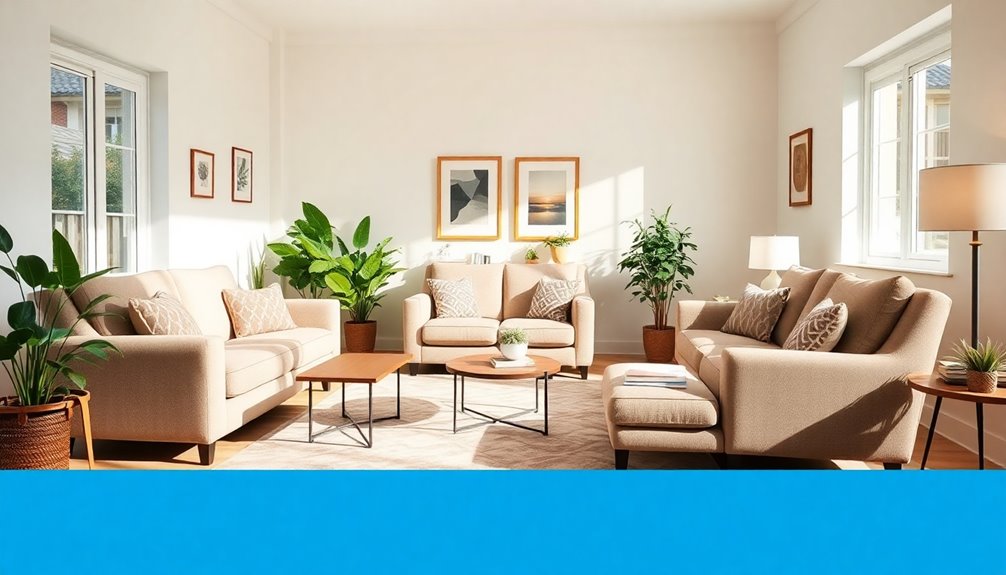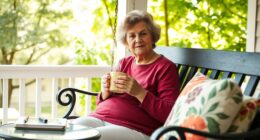To boost comfort and style for the elderly in your home, focus on universal design principles. Make entryways safe and accessible, optimize lighting for better visibility, and add convenient landing places. Enhance mobility by choosing non-slip flooring and adaptive furniture. In bathrooms, install grab bars and avoid obstacles for safety. Select supportive seating and create open pathways for easy navigation. These design choices guarantee a vibrant, functional space, and there's much more to explore!
Key Takeaways
- Choose furniture with proper lumbar support and armrests to aid sitting and standing, enhancing comfort for elderly individuals.
- Incorporate non-slip flooring throughout the home to minimize trip hazards and ensure safe navigation for seniors.
- Design well-lit spaces, particularly in entryways and staircases, to improve visibility and reduce the risk of falls.
- Select adjustable beds to cater to various sleeping positions, promoting better sleep quality and comfort for seniors.
- Arrange furniture to create open pathways, ensuring easy navigation for mobility aids and reducing clutter for a safer environment.
Understanding the Principles of Universal Design for Home Modifications
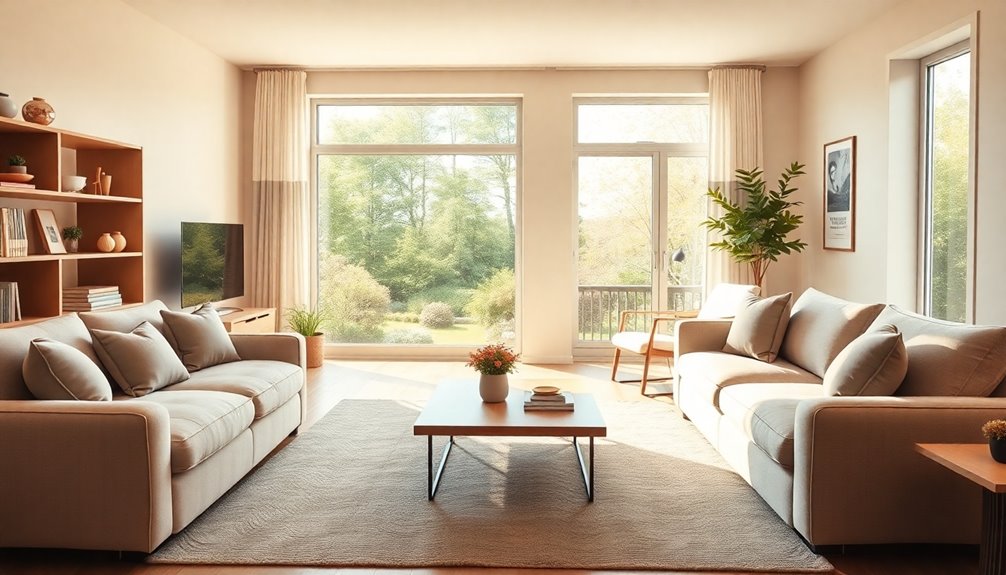
When you think about making your home more comfortable for elderly residents, understanding universal design principles is essential.
Universal design focuses on creating spaces that everyone can use, regardless of age or ability. By incorporating these principles into your home modifications, you enhance accessibility and promote independence in senior living. Key elements include using lever-style door handles, non-slip flooring, and well-lit pathways to accommodate mobility needs. These features not only improve usability but also reduce the risk of falls and accidents. Additionally, integrating features like assisted living expenses can further support seniors in maintaining their independence while ensuring their comfort. Implementing universal design principles can significantly enhance the overall functionality and aesthetic of a home tailored for the elderly. Moreover, incorporating elements of senior-friendly environments can create a warm and inviting atmosphere, making it easier for seniors to feel at home.
Creating Safe and Accessible Entryways for the Elderly

When designing entryways for elderly comfort, proper lighting is essential for visibility and safety. Bright, glare-free fixtures can help prevent accidents as seniors enter or exit their homes.
Additionally, adding convenient landing places like small tables or benches allows them to safely manage their belongings during changes.
Proper Lighting Installation
Proper lighting installation is crucial for creating safe and accessible entryways for the elderly, as it greatly enhances visibility and reduces the risk of accidents. By using bright, glare-free fixtures, you can greatly improve safety for senior citizens, especially during nighttime.
Consider installing motion-sensor lights that automatically illuminate entryways as they approach, offering both convenience and security. Additionally, guarantee adequate lighting along walkways, which not only aids visibility but helps emergency responders quickly locate house numbers during critical moments.
A thorough lighting strategy with well-placed fixtures can effectively reduce trip and fall risks, essential for older adults with mobility challenges. Ultimately, increased illumination at entry points allows seniors to navigate safely, compensating for age-related eyesight deterioration.
Convenient Landing Places
Creating convenient landing places near entryways can greatly enhance safety and accessibility for the elderly. These small tables or benches provide secure surfaces for placing items while entering or exiting, reducing the risk of accidents. Incorporating natural materials such as wood for these landing areas can add warmth and promote tranquility, creating a more inviting atmosphere. Adding decorative elements like mason jars can also enhance the aesthetic while providing functional storage.
A well-designed entryway with sufficient landing space allows for smoother shifts, improving overall quality of life. Keep landing areas clutter-free and easily accessible, ensuring seniors can navigate without tripping hazards.
Additionally, incorporating proper lighting around these landing places boosts visibility, minimizing fall risks. By including these features in your home, you contribute considerably to the independence of elderly residents, allowing them to manage their belongings safely and effectively, ultimately enhancing home safety and comfort. Moreover, integrating smart home devices can further assist in monitoring the safety of these areas through enhanced visibility and control.
Installing Proper Lighting

To guarantee safety and comfort for elderly individuals, installing adequate lighting throughout the home is essential. Bright, glare-free lighting fixtures should illuminate entryways and high-traffic areas, helping to enhance safety and prevent accidents.
Consider incorporating motion-sensor lights, which activate automatically as someone approaches, ensuring pathways are well-lit without needing to fumble for switches. Adequate lighting along walkways and stairs is vital, as it can markedly reduce the risk of slips and falls, especially for those with diminished eyesight.
Additionally, make sure house numbers are well-lit to assist emergency responders during critical situations. A thorough lighting strategy that includes ambient, task, and night lighting can greatly improve navigation and contribute to the overall quality of life for older adults.
Adding Convenient Landing Places

After ensuring that your lighting is adequate for safety, consider adding convenient landing places that can make daily routines easier for seniors.
Small tables or benches near entryways provide a secure surface for placing items, helping to reduce the risk of dropping belongings or losing balance. These landing areas enhance overall convenience, allowing for smoother shifts between indoors and outdoors.
You can design them to accommodate mobility aids, ensuring seniors can use these tools comfortably while managing their belongings. Strategically placing landing spots in high-traffic areas can help prevent accidents.
Additionally, incorporating storage compartments in these spaces can assist seniors in organizing their items, contributing to a clutter-free environment that promotes safety and accessibility. Furthermore, using well-drained surfaces in the design can enhance stability and prevent slips and falls.
Enhancing Mobility Throughout the Home

While it's essential to have a comfortable living space, enhancing mobility throughout the home is important for seniors' safety and independence.
Start by upgrading door hardware to lever-style handles, making it easier to operate doors without straining. Choose slip-resistant flooring to minimize trip hazards, ensuring a safer environment.
You can also minimize thresholds between rooms for smoother changes, enhancing overall mobility. Strategically place furniture to create clear pathways, allowing easy navigation without obstructions that could lead to falls.
Finally, consider incorporating adjustable furniture, like chairs with lumbar support and adjustable heights, to promote comfort and accessibility. Additionally, ensure that the air quality is maintained with regularly checking and cleaning filters to provide a healthier living environment.
These thoughtful modifications not only boost mobility but also encourage seniors to move freely and confidently within their homes.
Designing Elder-Friendly Staircases
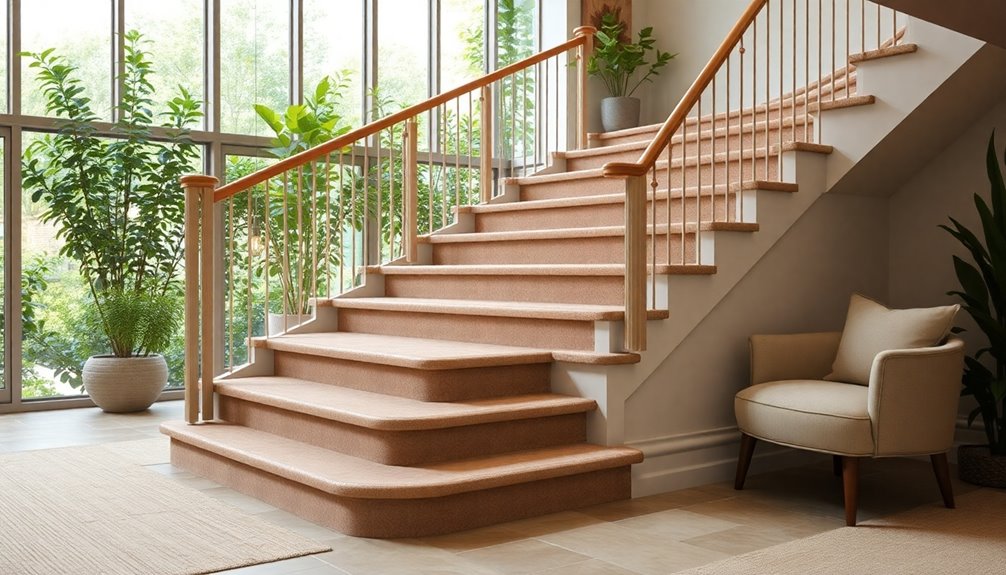
When designing elder-friendly staircases, start by ensuring you install handrails on both sides for maximum support.
Don't forget to enhance safety with proper lighting and consider using contrasting colors for better visibility.
These simple adjustments can make a big difference in helping seniors navigate stairs confidently. Additionally, maintaining a clean environment can further reduce allergens and pollutants, promoting a healthier and more comfortable space for seniors.
Handrail Installation Guidelines
To guarantee the safety and comfort of elderly users, installing handrails on both sides of staircases is essential. Handrails act as a vital safety feature, providing support for those with mobility issues and reducing the risk of slips. It's important to remember that routine health checks can help identify any mobility issues that may affect stair navigation.
Confirm the grip diameter is between 1.25 to 2 inches for a comfortable hold. Extend handrails at least 12 inches beyond the top and bottom steps for added support during changes. Choosing contrasting colors for your handrails enhances visibility, making it easier for older adults to navigate stairs safely. Regularly inspect handrails for stability and security to maintain ongoing safety. Additionally, the dangers of raisins for dogs can serve as a reminder of how important it is to be aware of potential hazards in the home environment.
Stairway Lighting Solutions
Effective stairway lighting is essential for guaranteeing the safety of elderly individuals traversing their homes. To improve safety and enhance visibility, make certain your stairway has overhead illumination that evenly lights the entire staircase.
Installing motion-sensor lights can automatically illuminate the stairs as you approach, preventing accidents during nighttime use. Consider using contrasting colors for handrails and steps to help visually impaired seniors identify boundaries, markedly reducing the risk of falls. Additionally, incorporating LED strip lights along the edges of each step can further enhance visibility and highlight the stairway's structure. A well-planned lighting design can significantly improve the overall safety of a home for elderly occupants. Regularly checking and maintaining light fixtures to guarantee consistent brightness is essential, as dim or burnt-out lights can create hazardous conditions on stairways. Furthermore, ensure that stairway designs accommodate accessibility options to provide additional safety for seniors with mobility issues. Maintaining good air quality in the home can also contribute to the overall comfort and safety for elderly individuals.
Finally, regularly check and maintain light fixtures to guarantee consistent brightness, as dim or burnt-out lights can create hazardous conditions on stairways.
Adapting Bathrooms for Increased Safety for the Elderly
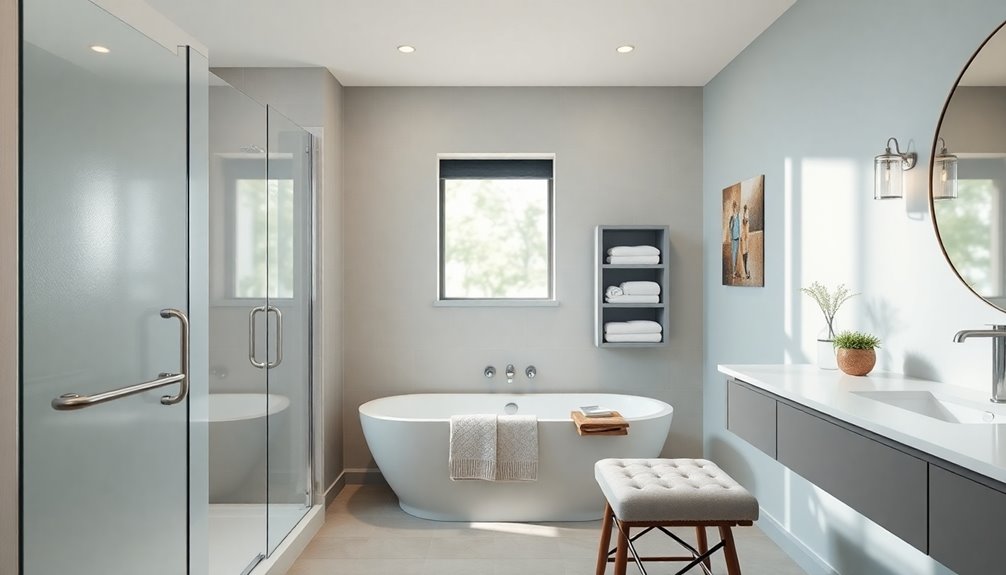
Creating a safe bathroom environment is essential for elderly individuals, as it can greatly reduce the risk of falls and injuries.
Start by installing grab bars in key locations, like near the toilet and inside the shower, to enhance stability. Non-slip flooring is critical, especially in wet areas, to prevent slipping. Additionally, using moisture-resistant materials can help ensure that the bathroom remains safe and durable over time.
Consider designing no-threshold showers, which eliminate tripping hazards and provide easier access for those with mobility challenges. Proper lighting is important too; bright, glare-free illumination improves visibility and helps prevent accidents, particularly during nighttime.
Regular maintenance checks on these safety features guarantee they remain effective, minimizing the risk of wear or instability. Additionally, incorporating security systems can provide peace of mind for both the elderly and their families.
Prioritizing these adaptations will make bathing safer and more comfortable for elderly individuals.
Optimizing Lighting for Aging Eyes

A well-lit environment plays an essential role in enhancing safety and comfort for elderly individuals, especially after making bathroom adjustments.
When optimizing lighting for aging eyes, focus on bright, cool white lights to improve visibility and reduce strain.
Implement thorough lighting strategies that include both ambient and task lighting to illuminate high-traffic areas and specific spots for reading or hobbies.
Consider installing motion-sensor lights in hallways and entryways, ensuring spaces are automatically lit when needed.
Additionally, place night lamps strategically in bedrooms and bathrooms to facilitate safe nighttime navigation.
Remote-operated switches can further enhance convenience, allowing seniors to control their lighting without risking trips or falls.
Carefully Consider Your Flooring Options
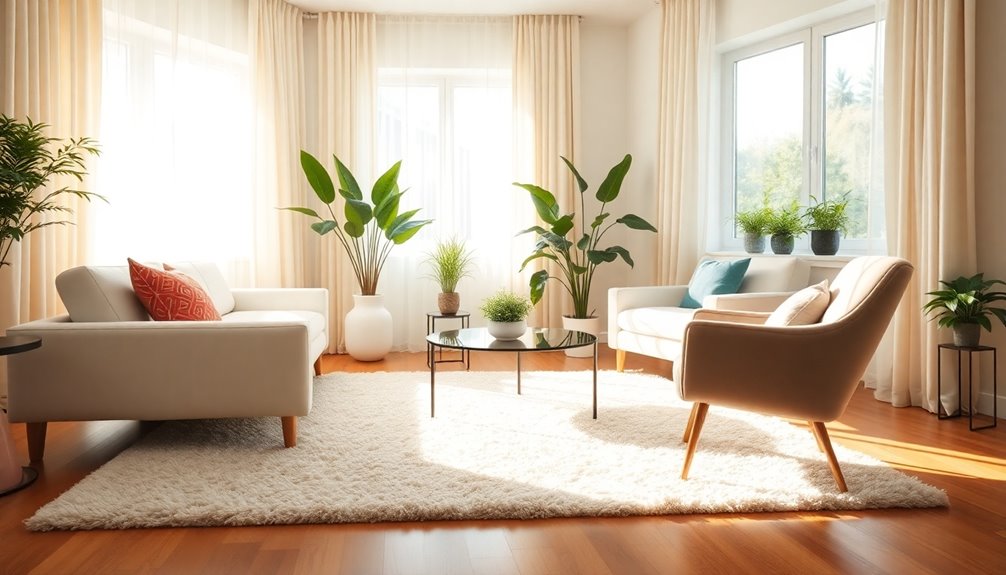
When choosing flooring, focus on non-slip surfaces to reduce fall risks, especially in bathrooms and high-traffic areas.
You'll also want to guarantee smooth shifts between different flooring types to prevent tripping hazards.
Balancing comfort with maintenance needs will help create a safe and inviting space for everyone.
Non-Slip Surface Selection
While choosing flooring for elderly comfort, non-slip surfaces should be a top priority. These surfaces greatly reduce the risk of falls, particularly in high-traffic areas like kitchens and bathrooms.
Options like anti-skid tiles and flamed granite not only enhance safety but also add aesthetic appeal by providing traction, even when wet. If you prefer vinyl, look for options with a cork layer; they offer cushioning for comfort and are easy to maintain while ensuring a non-slip surface.
When considering carpets, opt for low-pile varieties to minimize trip hazards. However, be cautious, as carpets can be challenging for wheelchair users and may collect dust.
Prioritizing these features enhances safety and accessibility in your home.
Consistent Level Transitions
To enhance safety and comfort for elderly residents, maintaining consistent level shifts between different flooring materials is essential. This practice minimizes tripping hazards and improves overall accessibility within the home.
Choosing flooring that remains the same height throughout not only elevates aesthetics but also prevents confusion that may lead to accidents. If your home is elevated, consider installing ramps to facilitate easy access for those facing mobility challenges.
Solid surface flooring, like hardwood or anti-skid tiles, is ideal as it provides a stable, easy-to-navigate surface, unlike thick carpets that can impede movement.
Regularly evaluating your flooring options and shifts allows you to identify potential hazards and make necessary modifications, ensuring your space adapts to the changing mobility needs of elderly residents.
Comfort vs. Maintenance Balance
Choosing the right flooring involves balancing comfort with maintenance needs, especially for elderly residents.
Prioritize non-slip surfaces to minimize potential hazards, particularly for those with unsteady gaits. Solid surface flooring, like hardwood or anti-skid tiles, offers easy cleaning and maintenance, enhancing functionality and accessibility.
Avoid thick rugs, as they can create tripping hazards; instead, consider low-profile options or eliminate rugs to guarantee smooth changes.
While carpeting provides cushioning in case of falls, it may hinder movement for wheelchair users, so think about individual mobility needs.
Maintaining a consistent level across different flooring materials not only enhances safety but also boosts design quality, reducing tripping risks at changes and making the home more comfortable for aging in place.
Senior-Friendly Furniture

When designing a space for seniors, selecting the right furniture is essential for their comfort and safety.
Opt for chairs with proper lumbar support and armrests to help them sit and stand with ease, minimizing strain on their backs. Choose senior-friendly furniture with sturdy bases and non-slip feet to enhance safety in the home environment, reducing the risk of accidents.
Look for adjustable beds that cater to different sleeping positions, improving comfort and mobility. Incorporate easy-to-reach storage solutions like lower shelves and pull-out drawers to avoid stretching and bending, which can lead to falls.
Finally, arrange furniture to create open pathways, making navigation easier for seniors aging with mobility challenges.
Frequently Asked Questions
What Is the 70/30 Rule in Interior Design?
The 70/30 rule in interior design suggests you allocate 70% of your space to foundational elements like furniture, layout, and color scheme, while the remaining 30% focuses on decorative accents.
This approach helps you create a balanced and cohesive room, ensuring comfort and functionality.
What Is the 60 40 Rule in Interior Design?
Imagine transforming your space into a stunning masterpiece! The 60/40 rule in interior design is your secret weapon.
It suggests filling 60% of your room with dominant elements—think wall colors or large furniture—while the remaining 40% can burst with vibrant accents like decor and accessories.
This balance creates a visual feast for the eyes, guiding you to the highlights while letting your personality shine through.
You'll create harmony and style effortlessly!
How to Design a Room for the Elderly?
When designing a room for the elderly, prioritize safety and comfort.
Start by ensuring doorways are wide enough for wheelchair access. Choose furniture with rounded edges and sturdy bases to prevent injuries.
Incorporate bright, non-glare lighting to enhance visibility, and use non-slip flooring to minimize tripping hazards.
Don't forget to install grab bars in key areas to promote independence.
With these elements, you'll create a space that's both functional and inviting.
What Is the 2/3 Rule in Interior Design?
The 2/3 rule in interior design helps you create balance by dividing a room's visual weight.
You'll use two-thirds of one color or pattern and one-third of another. This approach guarantees dominant colors complement accent shades, making the space feel harmonious rather than overwhelming.
Conclusion
Incorporating these interior design tips not only enhances comfort for the elderly but also adds a touch of style to their homes. Imagine a space where safety meets elegance, creating an inviting atmosphere that feels both secure and chic. By embracing universal design principles, you can transform any living area into a haven of accessibility and beauty. So, why not take the first step today? Your efforts can make a world of difference in their daily lives.
